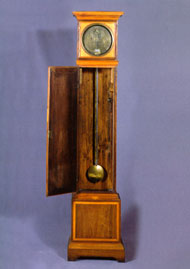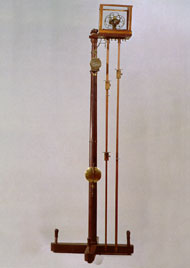|
João Jacinto de Magalhães (1722-1790)
 |
|
|
|
|
Pendulum clock signed by João Jacinto de Magalhães, which can be found in the Physics Museum of the University of Coimbra.
[Picture taken from the website of the Museu da Física da UC]
|
|
|
|
 |
|
|
|
|
Atwood machine, which can be found in the Physics Museum of the University of Coimbra. This machines was sent by João Jacinto de Magalhães.
[Picture taken from the website of the Museu da Física da UC]
|
|
|
|
Physic, chemist and instrument designer, born in Aveiro. Having started his studies at the age of 11, he entered the Colégio da Sapiência in Coimbra, which belonged to the Congregação dos Cónegos Regrantes de Santo Agostinho. The Monastry of Santa Cruz in Coimbra also belonged to this congregation, where the most famous Portuguese library since the Middle Ages was located. Here he studied Humanities, Greek and Latin. In 1743, he became a monk of this congregation and professed with the name of Frei João da Nossa Senhora do Desterro. In 1751, he became canon. In 1753, as a result of his knowledge of the physical sciences, Magalhães was chosen as guide to the officer of the French navy Gabriel de Bory when he visited Coimbra to observe an eclipse of the sun that was expected to occur on 26 October, in Aveiro, so as to determine the longitude of this city. These observations made it possible to discover errors in the existing calculations to determine the longitude of Aveiro. In 1754, Magalhães asked for the authorisation of Pope Bento XIV to abandon the monastery in order to undergo a “philosophical journey”. Before leaving the country, he witnessed the earthquake that destroyed Lisbon on 1 November 1755.
He left for France between 1756 and 1758. In Paris he met Ribeiro Sanches (1699-1783), who became his life-long friend. In order to survive, he published some books and translations. Through Ribeiro Sanches he met some of the most illustrious philosophers of the time, getting to know the ideals of the illuminist movement in depth. He also started to deepen his studies in Astronomy.
In 1762, he returned to Portugal but left again a year later to set up residence in London. Here he made contact with Emanuel Mendes da Costa (1717-1791), librarian and superintendent of the Royal Society. From London, he travelled frequently to France and Holland, having met up with some of the most well known philosophers of the time, such as Alessandro Volta (1745-1827), Lavoisier (1743-1794), Benjamin Franklin (1706-1790) and L. Euler (1707-1783), among others.
He did not go back to Portugal but kept up contacts with some Portuguese institutions, such as the Academia das Ciências de Lisboa, the University of Coimbra and with the Portuguese Government due to requests for scientific instruments to be sent to Portugal.
Works
Description des Octants et Sextants Anglois ou Quarts de Cercle a Reflection avec la maniere de se servir de ces instruments, pour prendre toutes sortes de Distances angulares, tant sur Mer que sur Terre (...),Paris, 1775; Description d'un appareil en verre pour composer des aux minérales artificialles. Londres, 1777; Description des nouveaux instrumens circulaires à reflection, pour observer avec plus de precision des distances angulaires. Londres, 1779; Description et usages des instrumens d'astronomie et de physique, faits à Londres par ordre de la cour de Portugal en 1778. Adressée dans une lettre á son excellence M. Louis Pinto de Sousa Coutinho, envoyé extraordinaire à la cour de Londres, etc. Londres, 1779; Description et usages des nouveaux barometres pour mesurer la hauteur des montagnes, et la profundeur des mines. Londres, 1779; Description et usages des nouveaux baromètres pour mesurer la hauteur des montagnes et la profondeur des mines. Londres, 1779; Essai sur la nouvelle theorie du feu elementaire, et de la chaleur des corps: avec la description des nouveaux thermometres. Londres, 1780; Notice des instrumens d'astronomie, de geodesie, de physique.... par ordre de la cour d'Espagne. Londres, 1780; Description of a Glass apparatus for making in a few minutes the best mineral Waters of Pyrmont, Spa, London, 1783 Collection de différents traités sur les instruments d'astronomie et de physique. Paris e Londres, 1775 e 1780; Description d'une Machine Nouvelle de Dynamique Inventée par Mr. G. Atwood, (...), Londres, 1780 ; Nouvelle construction d'alambic pour faire toute sorte de distillation en grand. (...), 1781.
Main scientific contributions
His reputation in the European scientific circles increased to such an extent that he exchanged correspondence with numerous scientists, namely with the astronomers Charles Messier (1730-1817), Bochard de Saron (1730-1794), Joseph-Jérôme de Lalande (1732-1807), Pierre Méchain (1744-1804) Nevil Maskelyne (1732-1811), N. Pigott (?-1804) and Thomas Hornsby (1733-1810). He produced several papers on Astronomy relative to the dissemination of the results of observations that were transmitted to him, to the dissemination of phenomena and to information on optical instruments. He received frequent orders for instruments with lenses, telescopes, parallactic machines, astronomical clocks and micrometers. He supervised the design and construction of these instruments by well-known constructors, such as Dollond and Ramselen. He also sent periodicals, logarithmic tables and charts to support the observations. In 1772, he was nominated by the Board of Navigation to oversee the navigational compasses of English ships, having become acquainted with the most advanced techniques of the magnetization of compasses of that time.
Very well known as an instrument designer, he also acted as disseminator of the most recent technical and scientific innovations. He published many articles in periodicals on issues like Astronomy, Medicine, Physics and Chemistry. He played a very important role in the scientific communication of his time, setting up an authentic network of correspondents throughout Europe. He was a member of several Academies such as the Royal Society, the Académie Royale des Sciences de Paris, the Academy of S. Petersburg, the Academia Real das Ciências de Lisboa, the Academy of Madrid, the Académie Royale des Sciences, des Lettres et des Beaux-Arts in Bruxelas, the American Philosophical Society in Philadelphia, the Royal Society of Arts, inter alia. In 1780, he founded, together with Richard Kirwan (1733 - 1812) and Adair Crawford (1748-1795), a small philosophical society called the "Chapter Coffee House Society", where Physics and Chemistry topics were discussed. He published articles in several scientific periodicals such as the “Philosophical Transactions” of the Royal Society and the Journal de Physique by Rozier. He played a major role in disseminating English scientific instruments and the work of Joseph Priestley to the French scientific community, at a key moment for the development of Pneumatic chemistry.
As an instrument maker, he proposed changes and improvements to astronomical and nautical observation instruments such as the quarters of a circle (English sextants and octants), in the reflection circle, in the sextant and in the pendulum clock. As far as meteorological instruments are concerned, he put forward improvements in barometers, thermometers and presented a meteorographer. As regards physical instruments, worthy of mention are his improvements to Atwood’s machines and to the precision scale, very important for the advances of Chemistry.
He accepted orders for scientific instruments for the Portuguese, Spanish, French and Prussian governments. He sent instruments to Portugal that were used to resolve the problem of the borders of Brazil between Portugal and Spain as well as to several institutions, such as the University of Coimbra, the Companhia de Guardas-Marinha, the Casa Pia and the Colégio Real de Mafra. Some of these instruments still exist in Portugal, namely in the Physics Museum of the University of Coimbra and in the Astronomical Observatory in Coimbra. It is also possible to find some instruments signed by Magalhães in several European museums and libraries.
In 1785, Magalhães proposed in a letter addressed to the American Philosophical Society the institution of a science prize for the best discovery or useful development in the areas of Navigation and Natural Philosophy. The founder and chairman at the time of the Society, Benjamin Franklin, acknowledged and accepted the proposal. From 1790 to 2000, 32 prizes were awarded with the name of Magalhães: The Magellanic Premium.
Fernando Reis
Hyperlinks
Museu da Física da Universidade de Coimbra
American Philosophical Society - America's First Scientific Award
Bibliography
CARVALHO, Rómulo de, A Física Experimental em Portugal, Lisboa, ICLP, 1982.
CARVALHO, Rómulo de, "Magalhães, João Jacinto de (1722-1790)", in SERRÃO, Joel, Dicionário de História de Portugal, Porto, Liv. Figueirinhas, 1981, Vol. IV, p. 138.
CARVALHO, Rómulo de, A Astronomia em Portugal no século XVIII, Lisboa, ICLP, 1985.
Conference on Physical Sciences in the XVIII Century, João Jacinto de Magalhães John Hyacinth de Magellan, Coimbra, Universidade de Coimbra - Fundação Calouste Gulbenkian, 1994.
MALAQUIAS, Isabel, A Obra de João Jacinto de Magalhães no Contexto da Ciência do Século XVIII, Aveiro, 1994, [Tese de Doutoramento - Texto policopiado].
MALPIQUE, Cruz, "Joäo Jacinto de Magalhäes, natural de Aveiro sócio da Academia das Ciências de Paris e da Real Sociedade de Londres", Sep. Arq. Distrito Aveiro, Aveiro,1971, 37.
SILVA, Inocencio da, ARANHA, Brito, Diccionario Bibliographico Portuguez, Lisboa, Imprensa Nacional, T. III, pp. 385-386.
VILAS-BOAS, Manuel, João Jacinto de Magalhães: um empreendedor científico na Europa do século XVIII, Aveiro, Fund. João Jacinto de Magalhães, 2000.
|
|


